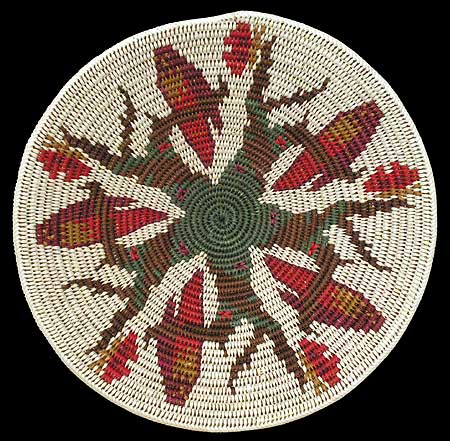Navajo
Basket by Alicia Nelson
Parakeets
11 1/2"
Diameter
Young and vulnerable to other's
opinions, Alicia Nelson has nonetheless learned to trust her
own instincts, and this has served her well as she has gone from
being an apprentice basket weaver to an artist in her own right.
Alicia trained under her mother-in-law, the famous Mary Holiday
Black, recipient of the National Endowments 1995 Arts Heritage
Award and fellowship. Living next to Mary, Alicia is very much
influenced by the master basket weaver, who still "gives
pointers," but now it is Alicia who helps Mary.
Together they gather sumac
from along the river for weaving. Alicia helps Mary with splitting
the willows and peeling the bark. "While I am helping her
she tells me stories about the past," says Alicia, "How
she and her family used to work with the sumac." Alicia
is one of only an estimated two dozen Navajo weavers who incorporate
pictorial images into their baskets.
Born in the Shiprock, New
Mexico, Alicia Nelson was raised in a traditional Navajo home,
but there were some things she would be surprised to learn when
she met Navajos from other areas of the reservation.
"I graduated from Red
Mesa High School," Alicia says, "and attended one year
at the College of Eastern Utah, San Juan Campus." That is
when she became acquainted with Jonathan Holiday. "When
I met Jonathan, his family was well known for their basket weaving.
I never even knew Navajos made baskets. I thought the Hopi tribe
made baskets, and we made Navajo rugs and sand paintings, because
that's what my family does. Jonathan's family laughed at me because
I didn't know Navajos made baskets."
It's not really surprising
that Alicia didn't know Navajos made baskets; for several generations
the art of basket weaving among the Navajos was nearly extinct.
Mary Holiday Black learned to weave as a child and was one of
the few who continued the practice. She taught her eleven children-
and anyone else who was interested to weave, preserving and enhancing
the tribal custom.
Having woven baskets for three
years, Alicia has a system. She has a book about basket weaving
which she says she reads from time to time. She draws a design
on paper and then hangs it on the wall so she can study it and
think about it. Her husband, also a weaver, may give her suggestions.
"From the beginning I
think about it," Alicia admits. "Then I talk to it
too." As she works on it she says she thinks about the Navajo's
past, and what the baskets mean to the people. "When my
hands start hurting (from weaving), I tell them not to ache like
this."
"I want to weave the
perfect basket," Alicia says. "Each one I do, I try
to make perfect."



